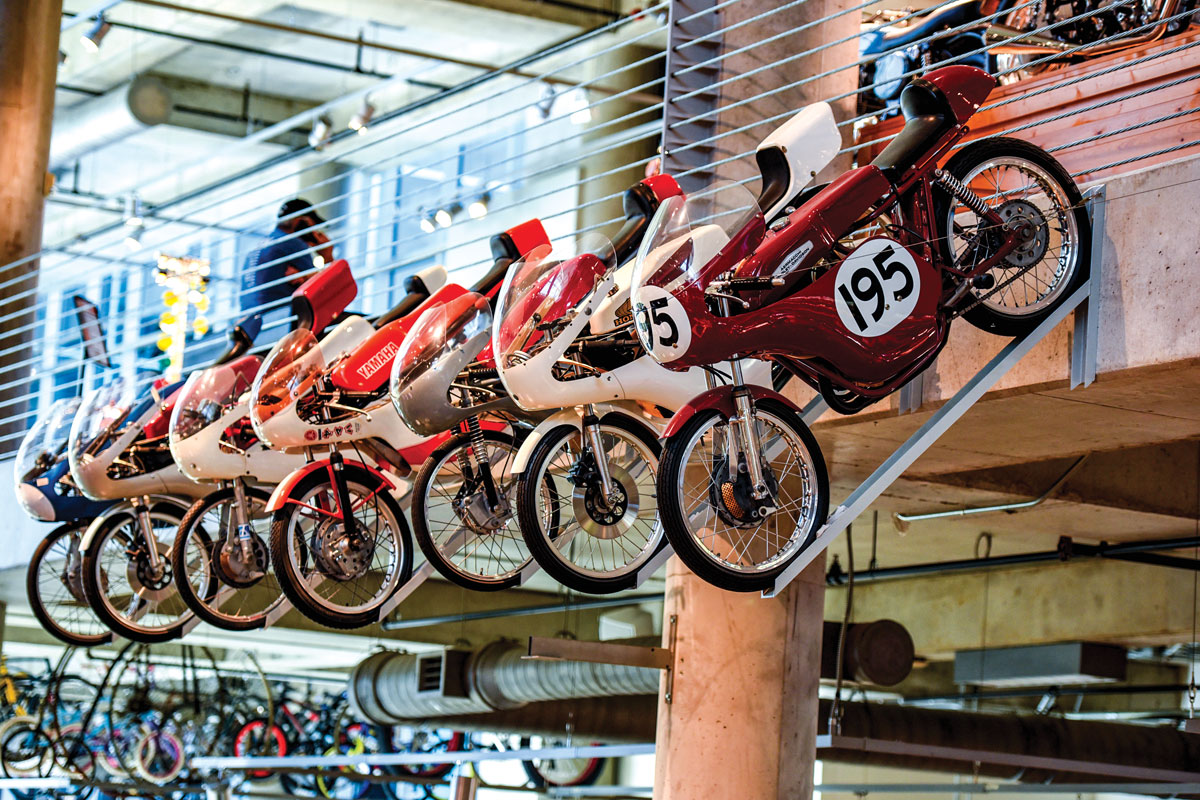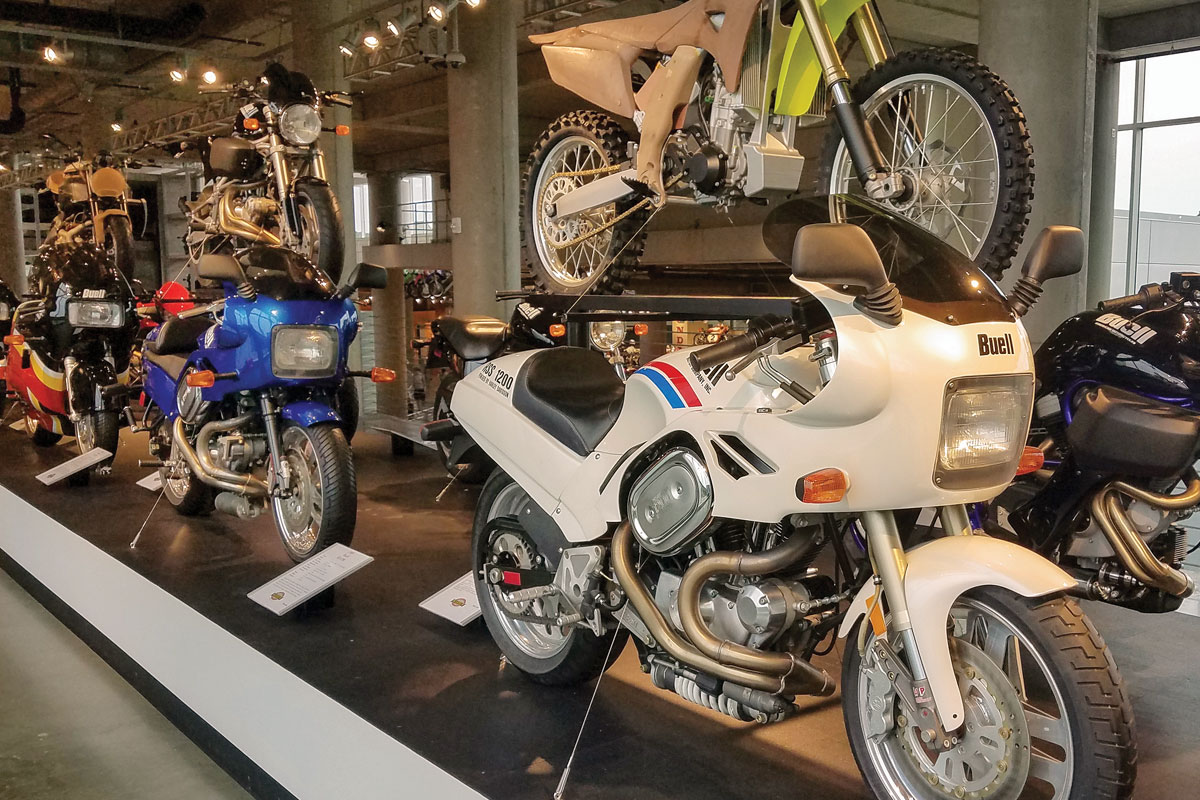
If the Barber Complex is motorcycling’s Oz, then its Executive Director Brian Case would be most akin to Oz’s mayor since founder George Barber holds the wizard title. Case has helmed the museum since 2023, overseeing an expansive and extensive collection of more than 1,800 motorcycles (with one thousand always on display) and more than 160 vintage automobiles, including the world’s largest collection of Lotus race cars. A quarter-million visitors tour the museum annually.

The monstrous museum’s glass and concrete exterior houses an interior design full of ramps and stairs — like a parking garage — that punches the senses like a pinned throttle punches a torque curve. Motorcycles dangle, float or live in floor to ceiling high display cubicles like a candy-colored matchbox car collection. Eras from the earliest and oldest to the latest and greatest motorcycles are categorized throughout the four floors, with special exhibits about racing and racers, pho tography, technology, and cars.
Aside from the enormity of the collection, and the Guiness Record Book’s designation as the largest motorcycle collection in the world, Case said the Barber Vintage Motorsports Museum stands apart from similar venues for several reasons.

“I think what would separate the Barber experience is probably the scale and the architecture, the scale of the architecture as you walk in, you’re just blown away with the scale of the place. And so, we have that element that makes us unique. We can spread out and spread the collection out, and you can walk around things, and you can breathe a little bit,” he said. “The second thing I would say is the racetrack makes us unique and having that track in our backyard. You can see it right from the windows inside the museum. So, at any given time you’re walking through the historical timeline of motorcycles inside, and out the windows, you can see the track where those things are demonstrated. The track is the very instrument of how those machines are operated and it’s right there in view.”
Unlike other museums with a sole purpose of looking backward to retell and preserve history, the Barber Museum has its sights set on looking ahead into motorcycling’s future. The building’s top floor houses the Design Center, an area dedicated to using technology’s latest advances to educate and inspire new generations of riders.
“The Design Center is part of the education program. When kids go through there they learn about and get an overview lesson of technology and design, and learn about things like 3-D printing, prototyping, and clay modeling that designers use to create new concepts and shapes.” Case said.
The Design Center is sort of Case’s baby, as he served as its director when it opened several years ago, before assuming his current executive director’s duties. The Pittsburgh native followed an unusual path to end up with the job he holds now. Case founded his own industrial design company after graduating college.
“That path ultimately led me to motorcycles, which are also just products, right? So, it kind of all clicked for me. I’ve loved motorcycles since I was five. I figured out that motorcycles were also designed, that they are an assembly of a bunch of little products that all must work together and look beautiful and be balanced and function. I really loved that part of design and created a career around it.”

Case’s client, Confederate Motorcycles, moved to Birmingham, and Case followed. In 2008, Case designed his own groundbreaking motorcycle and started the Motus Motorcycle Company, an American-made sport-touring motorcycle powered by a unique (for motorcycles) V-4 motor.
“I came to the museum a lot,” Case said. “That was my inspiration, so I would sit in the corners of the building on the couches with my sketch pad and just dream about ‘what could I do that would make a difference? The concept for the Motus bike came out of those sessions, where I was looking at the full view of international motorcycling in one building. I could sit back and see the whole picture. And that is what helped me establish what my concept was going to be.”
Motus eventually folded, but Case developed a friendship with the museum’s founder George Barber.
“He asked me how could we make the museum better? And I said let’s introduce people to the world of design and engineering. They’re already here looking at history, so let’s tell them how history is made. It’s the one component I thought was missing in the museum. My takeaway on the industry is that we must continue to work extra hard inspiring and finding new, younger enthusiasts. That spark of enthusiasm has to come from somewhere. It’s how everyone who’s in the industry now, that’s how they got it. They’ve been riding since they were kids or have some memory to fall back on when they were first inspired.”
Case said his motorcycling love began at age five thanks to a rider/father who, like Superman, would change from a corporate suit to leathers and go for a ride. Case would ride pillion, then began riding his own dirt bikes, but a visit to the Bonneville Salt Flats cemented the infatuation.

“So, I’m nine years old, and I got to see a streamliner go across the desert at 275 miles per hour, and I never forgot it. I can trace everything back to that moment,” he said. “Creating those moments for kids, creating moments that they’ll never forget, it gets embedded in their soul, and they’ll spend their entire lifetime trying to get back to that.”
Barber gives school tours of the Design Center, the museum sponsors many family-friendly events, such as the Vintage Days event, that offers free admission and special activities for children.
Stepping from engineering and technology to museum management presented different challenges for Case, and he says his first goal to not mess it up.
“When I came in, I thought what on earth am I possibly going to do to make this place better or contribute to it, because I have such high regard for it as it is? Now that I’ve been here awhile it’s fun because I really get to look at it analytically and ask, ‘Where can we grow, where are the gaps.’”
Case said he earmarked digital media as an area needing attention.
“When the museum began 30 years ago, Facebook and YouTube weren’t invented yet. So how to use that and reach out across the world to prove an experience to people who may never be able to travel here. That’s one of our goals.”
Continuing to preserve motorcycle history is definitely a strong goal for him, too. Not too long ago, vintage motorcycles meant bikes from the 1930s and 1940s.
“Well, now, vintage is like 1975, so we’re seeing a new generation vintage and it’s the first of the superbike era. These are 40- and 50-year-old bikes and preserving those is a growing challenge,” he said. “Now we’ve introduced plastics with fairings and race bikes. We’ve introduced exotic metals like titanium and magnesium. So now we’re learning how to properly preserve magnesium, preserve carbon fiber, all these modern materials that have come up in the last couple of decades that, as a museum, we have to really figure out because there’s no book on it. We need to constantly evolve our methods and processes to meet our goal of preserving history. It will be an ongoing priority.”
Curating the collection provides a unique challenge. Case says people approach the museum almost every day wanting to donate, which is great, but sometimes they have a gap in the collection and look for something to fill that.

“When I started working with the (Kenny) Roberts family, I quickly identified that we didn’t have anything representing his 60-plus year motorcycling career. We started communicating a couple of years ago, one thing led to another, and now his entire collection made its way here, all the memorabilia and the trophies that go back to the ’70s. It’s just unbelievable,” he said.
The Barber Vintage Motorsports Museum, at its core, stands as a storyteller that fuses sight, dimension, and tales into a walk through and into history, Case said.
Case said he also realizes the museum isn’t just about looking behind.
“There’s a breed of people, some still alive, that are just cut from a different cloth. And then there’s a gap. And that’s where I’m focusing, on transferring that knowledge and enthusiasm from the first generation of motorcycling to the next generation and the one beyond that,” he said.


